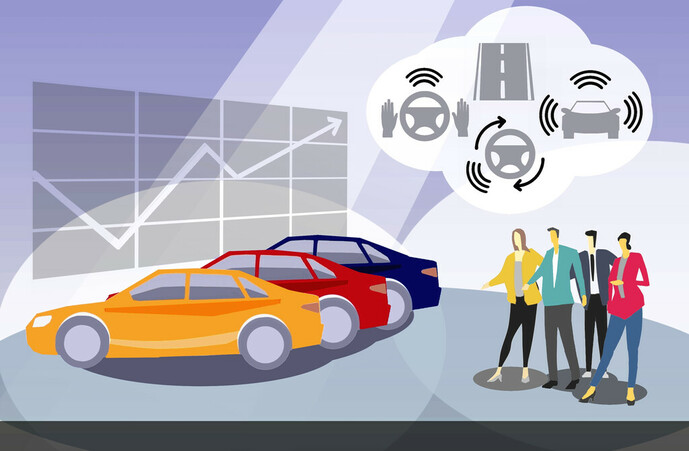auxiliary driving. Image: Authors’ Consortium for Mobility/Goslar Institute
Drivers in Germany are still very interested in driver assistance systems, as the Goslar Institute showed in a current analysis by consultancy McKinsey & Company. In a customer survey conducted for this purpose, nearly a quarter of the more than 25,000 respondents stated that they were very likely to want to order an advanced driver assistance system the next time they bought a car. Two-thirds of these clients agreed to, among other things, make a one-time payment of $10,000 for a Level IV Highway Pilot. Kirsten Heineke, partner at McKinsey and co-author of the study, explains this situation by saying that assistive driving is very attractive from a customer’s point of view. According to Heineke, it could make car commuting safer, more enjoyable and more productive.
However, the study authors also note for the first time a decrease in customer interest in fully autonomous vehicles from “Level 5”, and according to this, only 26% of those surveyed currently want to switch to a fully automatic car. For comparison: in 2020, this value was still 35% of respondents, McKinsey explains. The study authors argue that the main reason for this development is the decline in confidence in this technology: in the survey, 64% of customers said that the safety of self-driving vehicles had to be increased. The regulatory environment must also improve further, argues the McKinsey Heineke expert, although he admits he has already seen the right steps being taken in Germany and other countries.
In fact, highly automated driving has been permitted in Germany since 2023 at speeds of up to 130 km/h. This makes Germany a leader in the European Union: in May 2021, the Bundestag and Bundesrat approved a law according to which fully autonomous vehicles can in principle be used in Germany on public roads. The specific implementation provisions of the law will be gradually followed.
After all, the necessary legal framework has been established, ADAC commented. However, the ambitious timetable for self-driving car sharing in Germany had to be pushed back again and again, which the Automobile Club attributes at least to the fact that “the technology that car manufacturers had to develop and the legal status on the part of the legislature were clearly more more complex than expected.” This comes because German drivers don’t seem to be really convinced of the advantages of self-driving cars. The ADAC cites surveys on this matter, according to which 45 percent of drivers in Germany question the reliability of self-driving cars. Car technology or fear of hackers. “Digital ecstasy sees things differently,” says the ADAC.
A study of ADAC’s autonomous driving by the Prognos Research Institute posits that automated driving will only slowly take hold. The reason: On average, cars are used for up to 20 years, which is why new technologies only gradually appear in the overall inventory. According to Prognos, the proportion of new vehicles in which the driver can completely disengage from the task of driving on all highways should increase in the “optimistic” case from 2.4 percent in 2020 to at least 70 percent in 2050. From 2030 onwards, accordingly Cars with city pilots, that is, the ability to drive autonomously on the highway and in the city, are gradually appearing on the streets, and therefore they no longer need a driver, even on country roads.
For a better understanding: “Level 1” means “assisted driving” (with cruise control, adaptive cruise control, lane departure warning, etc.). In “Level 2” of “semi-automated driving”, vehicles can drive straight ahead on highways for a short period without the need for driver intervention, as well as take over steering, braking and acceleration. In Level 3 of Highly Automated Driving, drivers are allowed to divert their attention from the road, but are still required to intervene in the driving process and take control of the steering wheel if necessary. And the “fourth level” includes “fully automated driving”, in which the car moves completely independently on certain roads and the driver can opt out of the driving process. At this level of automation, it is possible to drive without passengers. The “5th level” of “autonomous driving” planned so far involves fully autonomous driving without any human support.
However, experts still feel that there is a great need for action and clarification before that can happen. However, it is also clear to them that the vision of self-driving is no longer a “theme of the future”, but that it is closer to reality than many people think. The potential of this technology is enormous, as ADAC confirms with reference to the study Prognos – for Society, Safety and Europe as a Business Site. Accordingly, this form of automation can better integrate the elderly or people with limited capabilities, make traffic flow more smoothly and freight transport more environmentally friendly – depending on the degree of automation – further reduce the number of accidents: finally, human error It is responsible for 90 percent of all accidents, which is why developing the best autonomous driving technology is so important, experts say. )
Homepage

“Certified tv guru. Reader. Professional writer. Avid introvert. Extreme pop culture buff.”






More Stories
Engineering/Technology: 67 teams from 24 countries at the ETH Zurich Cybathlon in Kloten ZH
Google is developing artificial intelligence technology that can control computers – Vietnam.vn
New residual waste bins of Euskirchen / Chip technology against illegally used waste containers – Euskirchen area